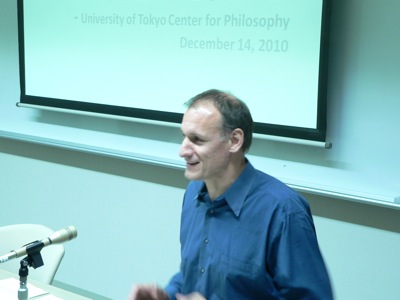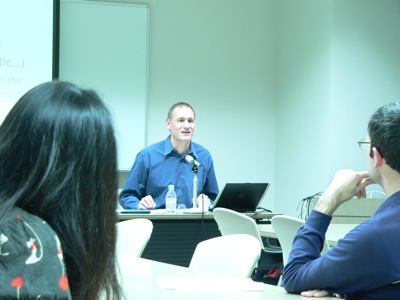【報告】Michael Raine, Film as a 'Synthetic Art'
On December 14th, Michael Raine (University of Chicago) gave a presentation entitled Film as a 'Synthetic Art': Imitation, Copyright Infringement, and Masquerade in the Toho Film Musical. As a point of departure, Raine invites us to consider the theme of "deprovincializing film studies", not merely in the sense of exploring non-Western theories of film, but by recalling alternatives to auteurist and political modernist approaches to the study of cinema. This inquiry was developed through an intellectual exchange with Miriam Hansen, in particular around the concept of "vernacular modernism".
[Michael Raine, University of Chicago]
In attempting to think and write a global history of cinema, film studies asks us to incorporate non-Western practices of film production and criticism. This has been especially significant in the study of Japanese cinema. While earlier attempts to write Japanese film history often presupposed (and thus reinforced) exotic difference, more recent studies have explored its “cultural permeability”, and the "geopolitical incline" between Japan and the West. For Raine, the three dominant traditions that came to define film studies have been: auteurism (which dates from the 1930s in Japan); political modernism (i.e., the so-called ideology of critical distance); and cultural studies. While these critical traditions have provided compelling interpretations of many genres and national cinemas, there are equally films which have not been well-served by them, such as musicals.
As an alternative to these critical approaches, Raine invites us to recall the social psychology of cinema. This was of interest to Bazin, and has particular resonance for the study of Japanese film, as there was a kind of "social psychology boom" among Japanese intellectuals during the 1950s. With the skyrocketing popularity of cinema during this decade, critics and intellectuals who had been concerned with mass culture turned their attention to film. Examples include: Nakai Masakazu, Minami Hiroshi, Satô Tadao, Hani Susumu, and Abé Kobo. As an approach to the study of mass culture, social psychology was marked by an interest in the popular audience, with cinema being understood as a space of agency and active reading. Minami, for example, studied fandom, while Abé Kobo looked at musicals as a form of anti-naturalist critique.
To illustrate some of the possibilities of this approach, Raine invites us to consider Toho musicals such as Janken musume (1955) and the Sannin musume series. These films, he suggests, may be read as forms of "synthetic art" [sogo geijutsu]. This concept was advanced by Abé Kobo in the late 1950s to express the sideshow-esque [misemonoteki] quality of film art. "Synthetic art" can be understood either in the Hegelian sense of multiple art-forms or in the more practical sense of being a group activity. Musicals express this through their tie-ins with other forms of mass culture such as popular music, celebrity and image culture, and as product placement for commodities and studio brands. Simultaneously, we can extend the concept of sogo geijutsu to indicate the combination of high and low culture that we see in "vernacular modernism" (e.g., cinema as art for department stores). Raine describes this as a mode of "transmedia exploitation", for which the Toho musicals serve as an exemplary format.
To understand film as sogo geijutsu, Raine further suggests that we consider the dimension of "everyday reflexivity", the space in which fans and stars are brought into a relationship that is mediated by cinema. Studio films, far from being simple entertainment are in effect didactic, teaching "fandom"; that is, forms of subjectivity based upon mass consumption. Fans dream of meeting stars, songs serve as quotidian utopias, and the subjectivity of the audience becomes mediated by performance (e.g., through imitation singing [mono-mane]). The fan comes into a relationship with star, not in the sense of "I want to be one of them", but rather: "I imagine they are me" (this is a line of Eri Chiemi's dialogue in Janken musume). Yet, the reflexivity of fandom also contains a hidden violence. For Raine, this is exemplified by an incident just following the release of the second film in the series, in which the star actress Misora Hibari was attacked with hydrochloric acid by a female fan.
The phenomenon of fans imitating stars — who are themselves imitating other stars — raises questions about how we think about reflexivity. It is significant that the reflexivity of fandom conflicts with the traditions of film theory that elevate political modernism and critiques of the culture industry. While the "solutions" offered by these films seem boxed in by the industrial logic of capitalism, the approach of social psychology delineates a potential space of reading that is not contained by the filmic text. Rather, it is a tissue of intertextual, transmedia and transcultural relations. Here, an unresolved problem remains for theorizing this transmedia exploitation, insofar as there is nothing necessarily "progressive" or "critical" about the space of reading. It is not a deconstruction of what the films conceal.
The ambiguity of the space of reading opened by transmedia exploitation is also entangled with a certain cynical awareness of the "geopolitical incline" between Japan and the United States. For example, the Japanese musicals include frequent citations of American productions (e.g., West Side Story, My Fair Lady), they belong to a moment in which "the copy is better than the original", but conversely such films could not be exported to foreign markets due to the 50s film practice of imitation singing [mono-mane]. While critics such as Kawakita Kashiko thought these films represented contemporary Japan, in effect mono-mane was a pervasive form of copyright infringement that rendered the films unexportable.
Raine argues that following the anti-ANPO movement of 1960, the interest in social psychology and the "culture of the copy" yielded to a greater interest in allegories of resistance and, generally, the "culture of authenticity". In effect, ANPO changed the "structure of feeling", and critical interest in musicals was pushed aside. This may be seen as part of the political modernist rejection of commercial cinema and its values, trading the breezy pleasures of confusing original and copy for a more focused engagement with values of criticism, autonomy, and authenticity. Nevertheless, to place an organism like ATG or "independent" directors like Oshima squarely on the side of "authenticity" would be to ignore their commercial entanglements with the mainstream system of distribution.
Yet, by examining studio films as forms of synthetic art, we can explore how mass culture offers the public a "space for reading", a form of self-reflexivity for audiences to think about their place in society and the world. It is, nevertheless, a form of attention, not critique. As film and cultural historians looking at this phenomenon fifty years later, these forms of "postmodern" reflexivity raise important questions for thinking about postwar Japan. The social-psychological approach to reception engages with ambigity rather than critique, but it also spurs us to think about transcultural mimesis in new ways: as forms of submission, dominance, and learning.
(Report: M. Roberts)









